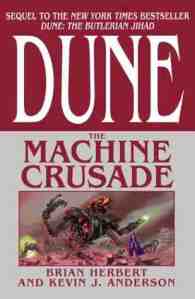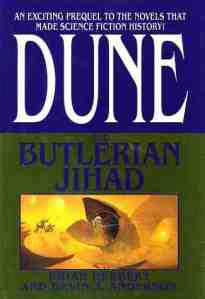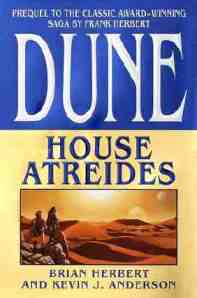 Ah, the profits must flow.
Ah, the profits must flow.
-Aurelius Venport
Twenty-five years ago, the death of Manion Butler incited humanity against the machines that ruled them; the conflict quickly ramped up into a religious frenzy-an attitude that Omnius is ill equipped to understand. Regardless, though, the war between the Synchronized Worlds and the League of Nobles has largely remained a stalemate. And after twenty-five years of war, things start getting interesting. The Machine Crusade covers a period of seventeen years-a span which sees the birth of objects and ideas that are destined to live on for hundreds of years. Let me add, though, before I get into the meat of this review, that if you really want to see what went on in those missing twenty five years, there’s a handy appendix that hits the highlights. I’d recommend reading the main book first, though.
And with that-on with the show!
The book opens with the Army of the Jihad getting ready to repel an assault by the thinking machines on IV Anbus. The Army is ready on two fronts-ground forces held by Xavier Harkonnen, and the forces in space led by Vorian Atreides. Their task is complicated, though, by the fact that the native population doesn’t really want them there-no matter how hard Xavier tries to convince them that really bad things are on their way; an example of the dangers of pacifism taken too far. In the meantime, Iblis Ginjo has become the Grand Patriarch of the Jihad, mostly by manipulation-as Serena Butler spends much of her time in seclusion, as an occasional target of assassination attempts (not all of which originate from Omnius). Iblis is quite happy with the power he has, and has worked very hard to keep it.
On other fronts: Agamemnon and his band of Titans haven’t really advanced their goals of taking control back from Omnius…but they haven’t given up, either. They are, however, in for some surprises in this book. On the world of Poritrin, Savant Tio Holtzman is still cranking away at developing new inventions-or at least, trying to; the real power behind him, Norma Cenva, is consumed with the idea of an even faster method of space travel-one that would actually fold space in order to reach a destination. This suggests some very interesting possibilities to Aurelius Venport, the head of a merchant company. Erasmus is also still around, still in the good graces of Omnius (possibly because the Earth-update version of Omnius never made it back to the Synchronized Worlds…yet….), and ready to analyze yet another aspect of human behavior-an aspect that is highly relevant to the present conflict. And the saga of Selim Wormrider continues…!
If one thinks of the Jihad proper as the main storyline of this series, then one could also point at lots of little subplots (and not so little) that flesh it out further. Mercenaries of the world of Ginaz are a potent force in this war, and Jool Noret is very likely the first who could be called a Swordmaster-even though he crowds out everything else in his life to bring destruction to the machines (and he’s undergone a very interesting method of training, all things considered). Zufa Cevna, a Sorceress of Ruvak, decides to bear a child from someone new, and her choice is an…interesting one. Savant Holtzman and his benefactor’s treatment of the Zenshiite and Zensunni slaves leads to a predictable outcome, one which leads some of them to an uncertain destiny. Vorian Atreides discovers the personal cost of fighting in a war in which-barring accident-he will outlive almost everyone he knows; he also has the wit to put a very clever plan into action against Omnius. Norma finds that there’s a bit more to her than an extremely keen intellect. Even the Cogitors take a hand-but not as anyone expects.
It’s fun to see how some things start to shape what will one day become the institutions seen in the original Dune book: we still see the development of what may become the Bene Gesserit, but we also get a chance to see the very beginnings of the Guild, the technologists of Ix, the Tleilaxu (I think; I’m still not 100% certain), and the effects of that most rare of substances-melange. And for the first time, somebody gets a hint of the far future-a future that resounds with a single name on the lips of his followers. To be honest, there’s so much going on that has links with other goings-on in this book that it would spoil a whole lot if I went into any kind of detail at all; but the authors continue to impress me with how everything hangs together.
The book concludes with a number of turning points-some for the better, and some for the worse. The Machine Crusade is an excellent continuation to the Legends of Dune, and has me looking forward to the next and final book in this trilogy; even now, I can’t begin to guess how things are going to fall out here. Expect to spend some time reading this book, though, because it’s at least a heavy a read as the last one!




